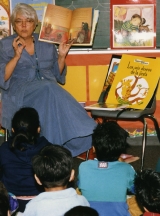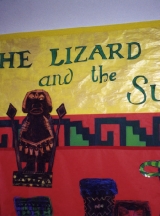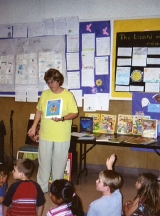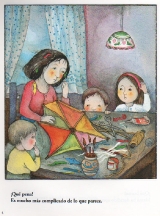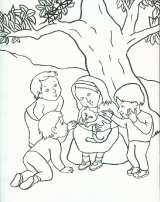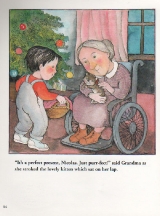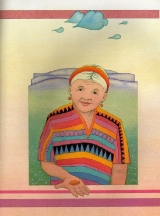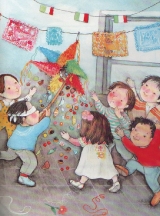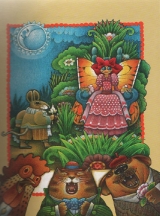Archive for December, 2009
The Christmas Tree/ El árbol de Navidad
Wednesday, December 16th, 2009BOOK DESCRIPTION
This delightful cumulative text, in both English and Spanish, radiates the joy of holiday traditions and the warmth of family love. An excellent book for emergent readers, which can easily be transformed into a simple play. Illustrated with powerful colors by Terry Ibáñez.
AUTHOR’S NOTE
Christmas was always a very special season of the year for me as a child, and later a wonderful time to share with my children and our large family. Some of the names of the characters in the story are names of real members of my family like my son Alfonso, and my wonderful aunt Mireya. For some real life information on our unusual Christmas celebration, you can look up “Christmas for All” (in Under the Royal Palms) “Navidades para todos” (en Bajo las palmas reales).
REVIEWS
School Library Journal
The meter and appealing rhyme scheme of the cumulative verses apparent in the Spanish text are missing in the English version. The simple story centers on a Christmas tree and the joy it brings to those who assemble to decorate it. Straightforward sentences describe, first in English, then in Spanish, one thing that each family member contributes to the tree. As each decoration is repeated, the refrain grows longer. “Look at the beautiful Christmas tree/with the bright candle/Grandma lit,/the candy cane/Grandpa hung,/the sleigh/Uncle Irineo painted,” etc. The artwork, done in acrylic paint on black paper, features deeply saturated background shades of red, orange, blue, green, and violet. The figures are portrayed in a primitive, folk-art style and the dark hues chosen for the backgrounds and festive, decorative borders give them depth and texture. A visually attractive addition especially for bilingual and Spanish-language collections.
Publishers Weekly
“One by one members of a family add decorations to their Christmas tree, and Ada’s cumulative text charts their offerings –from Grandma’s candle to Uncle Irineo’s painted sleight ornament. With a line of text in English followed by the line in rhyming Spanish, the quiet graceful narrative is complemented by Ybáñez’s folk-art style illustrations, rendered in acrylic on black paper. Simple borders start out incorporating a single visual element –candy cane, stars, a spring of evergreen –and grow gradually more intricate as additional ornaments are added.” (Publishers Weekly, October 1997).
School Library Journal
“[…] The simple story centers on a Christmas tree and the joy it brings to those who assemble to decorate it. Straightforward sentences describe, first in English, then in Spanish, one thing that each family member contributes to the tree. As each decoration is repeated the refrain grows longer. “Look at the beautiful Christmas tree / with the candy cane / Grandpa hung, / the sleigh / Uncle Irineo painted,” etc. The art work, done in acrylic paint on black paper, features deeply saturated background shades of red, orange, blue, green, and violet. The figures are portrayed in a primitive folk-art style and the dark hues chosen for the backgrounds and festive decorative borders give them depth and texture. A visually attractive addition especially for bilingual and Spanish-language collections.” (School Library Journal, November 1997).
READERS’ RESPONSES
If you have enjoyed reading or sharing this book, I would very much like to hear from you. Please click here to send your comments.
Tales Our Abuelitas Told
Tuesday, December 15th, 2009RECOGNITIONS
Literary Guild Medal
Kirkus Best Books, Kirkus Review
A Parent’s Choice Recommended Book
Best Books of the Year, Books for a Global Society SIG – American Library Association
Best Folklore in Best Books of the Year, Nick Jr. Magazine
Featured Book of the Month, Colorín Colorado Website, American Federation of Teachers
List of Best Books for 2006, New York Public Library
BOOK DESCRIPTION
Twelve stories from varied roots of Hispanic culture come together in a colorful collection that includes talking ants, magic bagpipes, dancing goats, and flying horses. In some cases the tales emphasize a moral, such as looking for the good in any bad situation as in “Catlina the Fox.” In others, the story illustrates the importance of friends, as in the case of “The Bird of One Thousand Colors.”
The authors seek to trace the origins of the stories through personal source notes, citing variants of the original story and the historical themes behind the tales. Of note is a tale of Juan Bobo that is included in this collection. Juan Bobo has entertained children and adults for more than five centuries with his antics and absent-mindedness. While Juan Bobo is well known by many, “The Bird of One Thousand Colors” is a story that Alma Flor Ada was unable to trace to an original source, although she remembers being told the story by her grandmother.
Throughout the collection, culturally accurate illustrations catch the eye with vivid colors and intricate details that convey aspect of the story. Each story leads naturally to the next, keeping alive the oral traditions of a rich culture that spans the continents
AUTHORS’ NOTE
Writing Tales Our Abuelitas Told was for me a way of honoring my extraordinary grandmother, Dolores Salvador, as well as and an expression of love and hope for my nine grandchildren, as I have expressed in my dedication. I am sure it means something very similar for Isabel, whose dedication is to her great-nephew Pablito. We are very grateful that these beloved tales are being so well received assuring that their continue to live for all children.
Traditional tales open our hearts to old voices and new worlds, to wondrous adventures and ever lasting feelings. Words like Había una vez or Érase que se era, hold for the listener or reader the magic promise of enchantment.
The stories retold Tales Our Abuelitas Told or, in the Spanish version Cuentos que contaban nuestras abuelas, reflect the diversity of our culture: some developed in Latin America from Indigenous roots, others had their origin in Africa or in various regions of Spain and go back to the Hebrew, Arabic or Basque traditions.
Their settings may be Mexico or the Southwest, Puerto Rico, Cuba or the Amazon among many others. They all keep children spell-bound. Stories like these enriched our childhood and left our imagination forever open to new discoveries, to the daring possibility of dreaming better worlds. Words like ¨happily ever after¨ got transformed into lives in search of understanding and compassion, lives devoted to promote access and equality for all, social justice, and peace.
Image Gallery
BOOK REVIEWS
School Library Journal
Grade 3 & Up: The introduction to this delightful collection explains clearly how stories develop and change over time; in fact, the two storytellers heard most of these amusing tales when they were children and have retold them many times since in their own unique styles. Each retelling is accompanied by a brief description of its origin. Included are tales about dancing goats, a turtle that outwits a deer, and a beetle that declares war on a cow; all of the selections are peppered with energetic dialogue and witty detail. Children will relish their humor, especially if read aloud, and teens will also enjoy this lively presentation. Traditional story beginnings and endings are provided in Spanish and translated into English, including one foreboding opening: In a land where you will go but from where you will never return. Four Latino artists provide an interesting variety of illustration. Featured images include a large goat head in a vegetable garden, a large farmer on a very small burro, and a wolf and fox all decked out in finery dancing together. The last page provides information about the authors and illustrators. Many libraries may already have Lucia M. Gonzalez’s Señor Cats Romance (Scholastic, 2001), but only one tale is common to both collections. Make room on your shelves for this excellent book.
Booklist
The long chatty notes are as interesting as the 12 folktales in this anthology of stories retold by Ada and Campoy and illustrated by well-known Latino artists. The authors celebrate Hispanic culture and its many roots–indigenous, African, Spanish, Arab, Hebrew–assembling tales from as far afield as Spain and Idaho, and showing how the tales have transformed and influenced one another, and even how Ada and Campoy have changed them. The folklore universals are here: the kid who defeats his mean older brothers; the huge monster routed by an ant; and more. In “Blancaflor,” the evil king’s daughter and the young prince fulfill three tasks together and prove the power of love. The spacious book design will work well for both independent reading and reading aloud, and each story is illustrated with one or more full-page pictures in styles that match the stories–from busy and filled to bursting to light and airy.
Children’s Literature: A six-page introduction welcomes readers and offers historical background into the ways that folktales originated and intermingled in all cultures. The twelve Hispanic tales actually have roots in many ancient traditions. The conversational tone continues into the retelling of the selected tales ranging in length from three to seventeen pages (including at least one full-page illustration for each). A few of the tales will seem somewhat familiar. “Dear Deer! Said the Turtle” is reminiscent of “The Tortoise and the Hare.” “The Castle of Chuchurumbe” has a rhythm similar to “The House That Jack Built.” Catalina the Fox could be related to Brer Rabbit. Other tales bring fresh, new perspectives. Pedro saves his family’s corn and, eventually, finds great happiness because he befriends a little horse of seven colors and follows its advice. A caliph and his son discover the source of true happiness in unexpected places. Research and explanatory notes follow each tale. Colorful illustrations capture the mood of the narrative, often contributing to understanding of the text and adding humor. The artists are given individual recognition in the table of contents. A listing of traditional folk tale beginnings is provided in both Spanish and English in the front of the book. A similar listing of endings appears in the back. The large-style format lends itself well to both individual reading and group sharing.
Reseñas/Book Reviews Berkeley Public Library
An illustrated collection of lively stories – reflecting elements of Spanish, Arabic, Celtic, African, Jewish, and Mexican roots – retold by the dynamic Ada and Campoy duo. The cuentos include several from Cuba, others from various regions of Spain such as Galicia and Andalusia. Also reflected is Spain’s diverse population: farmers in the North and Califs that once ruled the South of Spain. The selections hold universal appeal, employing themes common to many folklore collections. Accompanying the entries are captivating illustrations from four outstanding artists, each using his/her unique artistic style to capture the reader’s attention. The authors’ historical knowledge of the stories is evident in the notes that introduce this volume. With a few minor problems relating to the origination of the stories, this is a wonderful book.
COMMENDATIONS
Simon Brooks:
I have gone into the studio to begin recording what is most likely to be called “More Second-hand Tales.” I know, amazingly original, isn’t it? For those who saw me over this summer, you might remember me telling the story ‘The Goat from the Hills and Mountains.” This tale was new to me this year and I have fallen in love with it. It is based on an Hispanic tale I found in a marvelous book called TALES OUR ABUELITAS TOLD by F. Isabel Campoy and Alma Flor Ada, published by Atheneum. I could not find an original source for the story, or any other version of it, so I approached the authors for permission to continue telling the tale and also for permission to record it, on this soon-to-be-made second CD. After a few emails with both writers I have permission to continue to tell the story AND record my version of Alma Flor Ada’s version of this story which appears in the book. The book is wonderful, and there are many other great stories in there. If you are looking for a holiday gift to give someone this coming winter season, be it Christmas, Chanukah, Quanza, or any other holiday, or birthday even, then look this book over. It is not a ‘dry’ folklore book, but a book filled with the life and vitality which makes Hispanic stories so wonderful. It is also illustrated in a style that captures the tales in a unique way that kids love. I know this as we have a copy of it at my library. Many thanks to Isabel and Alma for graciously allowing me to take this tale and put it on my second CD.
BLOGS
Tales Our Abuelitas Told is a lovely collection of Hispanic folktales from many different cultures, written/retold by F. Isabel Campoy and Alma Flor Ada. Abuelitas is an endearment in Spanish for “grandmothers,” and these tales, full of life lessons, are told with the loving care of our grandmothers.
These stories have journeyed far — over mountains, deserts, and oceans — carried by wind, passed on to us by our ancestors. Now they have found their way to you.
A sly fox, a bird of a thousand colors, a magical set of bagpipes, and an audacious young girl … A mixture of popular tales and literary lore, this anthology celebrates Hispanic culture and its many roots — Indigenous, African, Hebrew, and Spanish.
In the introduction to the book, the authors explain the history of Hispanic folklore, which I found fascinating. Twelve tales are retold and beautifully illustrated, each one ending with a brief explanation of the different versions of the story and the authors’ connections to it. My favorite was “The Happy Man’s Tunic,” a story brought to Spain most likely by the Arabs. In the story, a caliph was too busy to spend time with his kind and loving son. When his son became ill, the caliph consulted many physicians. But when none of them could find the right cure, and he despaired, an old woman came to him and told him that all his son needed to get well was to wear the tunic of a man who is truly happy. The search was on, and a young shepherd was finally found who proved to be a truly happy man. The problem was…he didn’t own a tunic! It’s a fun story with an important message, but I won’t give it away here.
The authors also included a fun list of traditional beginnings and endings to stories told in Spanish, side by side with their English-language equivalents:
Había una vez…
En los tiempos e la abuela…
Hace mucho tiempo…
…y colorín colorado, este cuento se ha acabado.
Once upon a time…
In Grandmother’s time…
A long time ago…
…and, my many-colored feathered friend, now the story has found an end.
It’s exciting to find a book of folktales that is done so nicely. This is a lovely book, beautifully written and illustrated, and it would be a great addition to a family’s collection of folktales, and a wonderful book to use as a teaching tool in school for any age group. –Christine
READERS’ RESPONSES
If you have enjoyed reading or sharing this book, I would very much like to hear from you. Please click here to send your comments.
Serafina’s Birthday
Tuesday, December 15th, 2009BOOK DESCRIPTION
Sebastian has overslept and almost misses his train, his only way to get to his best friend Serafina’s birthday party. Although he manages to catch the train his misadventures are only beginning: on rushing to the station he has forgotten Serafina’s gift. Fortunately he has his wallet… but how good is a wallet when being Sunday, all the village stores are closed? Sebastian sets out to get a present, any present. But his efforts bear no fruit… he is chased by a cat, a bunch of squirrels and some angry crows.
Finally, defeated, he decides to show up for the party even if he is not bringing a gift.
Grandpa, the family storyteller, has a cold and has not made the party. When Sebastian sits down on Grandpa’s chair and begins to tell his adventures all the bunnies present are delighted. A birthday party without stories would not be a real party: Sebastian has indeed brought the best gift of all!
AUTHOR’S NOTE
This book was born out of a child’s request for a story. I was baby sitting Olmo, the grandson of my good friend Viví Escrivá whose beautiful art enhances so many of my books. We were in Viví’s country home in the beautiful town of Polop de la Marina, very close to the Mediterranean coast in the province of Alicante, Spain. Viví’s oldest daughter, Ana, had just arrived home with a beautiful bunny rabbit and Olmo was very taken by the bunny. When I offered Olmo to make a story just for him, trying to keep him close to me –quite a feat with Olmo as you can read in my Author’s Note to the book Olmo and the Blue Butterfly – he suggested the story should be about a bunny. I was about to begin a bunny story when he added: “and a train.”
Now, that was the magic clue, put together a bunny and a train and what does one get? The rabbit Sebastián who has problems being on time and almost looses the train on a most important day, Serafina’s birthday.
This was one of my first books published in the mainstream trade market in the United States and is such a source of joy. When the book went out of print –oh, how much damage an insensitive book review can cause! —I felt a great sense of loss. This had always been a favorite story to tell. It also was a favorite of my great-nephews, children of my sweet niece Marcie Fellers Pettit. She could never understand that the book would be kept from other children to enjoy as much as hers did.
Fortunately, a story can have many lives. Now Serafina’s Birthday or is available as a play in the book Roll-n-Role or as El cumpleaños de Serafina in Teatrín de don Crispín in the Gateways to the Sun or Puertas al sol theatre collection
READERS’ RESPONSES
If you have enjoyed reading or sharing this book, I would very much like to hear from you. Please click here to send your comments.
Saludos al público
Tuesday, December 15th, 2009BOOK DESCRIPTION
This theatre anthology includes five plays. Two original plays by F. Isabel Campoy: Busco un socio para mi negocio and Amistad, divino tesoro. The play Los dos hermanos is a dramatization of a traditional Jewish tale, by Alma Flor Ada and F. Isabel Campoy. La cena de tío tigre is a play by Clara Rosa Otero, based on a traditional folktale and La carrera del grillo y el caracol is a wonderful play in verse by Mireya Cueto.
The book also includes seven sections that will teach children about various aspects of the theatre, its history, the vocabulary related to the theatre, and will facilitate their involvement with different forms of staging a play: Para jugar a los títeres. Participantes en una representación teatral. Vocabulario propio del teatro. Vocabulario relacionado con los títeres. Cómo nació el teatro. Para jugar al teatro. Cómo montar tu propia obra.
USING THIS BOOK
The value of involving children with theatre are multiple. Plays can be an excellent tool for promoting the leadership skill of being able to speak in front of a group. Since they offer children the opportunity to utilize words and language registries they may not have other opportunity to use, plays can be strong vehicle for vocabulary and language development.
When used for choral reading plays can strengthen reading skills. In addition, acting in a play enhances children’s self-confidence and self-esteem while providing opportunities to learn about one’s self and others. Most importantly, putting on a play, no matter how simple, promotes the values of collaboration and solidarity.
To read more on the significance of theatre click here: Let’s Raise the Curtain! The Benefit of Theatre in the School and for suggestions on its use in the classroom read the section “Plays and Dramatic Games” in Chapter 3 of A Magical Encounter: Latino Children’s Literature in the Classroom and for dramatic responses to books, the section “Promoting Dramatic Expression” in Chapter 4 of that same book.
AUTHOR’S NOTE
Ensuring that children have access to read and act in plays has always been one of my basic concerns. Even if it is done with great simplicity acting in a play can have very positive results. It certainly was so for me. Encouraged by my extraordinary sixth grade teacher, Dra. Rosa María Peyrellade, I wrote my first play which we performed in class. As a high school student I wrote three plays, and while very simple, my classmates performed them with enthusiasm. We invited the High School Faculty of the Instituto de Camagüey to the premier of one of them, which I entitled La sonámbula or The Sleep-walker. Even though some of the professors did not enjoy the criticism to their very traditional pedagogy which was part of the performance, there was enough interested public that we rented the best theatre in town, el Teatro Principal to give a couple of public performances.
When I became a High School teacher at the Colegio Abraham Lincoln in Lima, Perú, I invited my students to do theatre and we had great fun doing so!
My mother, a coordinator for FLES [Foreign Language in the Elementary School] in Atlanta, Georgia, used theatre very effectively in the teaching of Spanish, and wrote a number of plays that were performed by children and broadcasted via the district TV station.
As a teacher educator in the United States I have continuously emphasized the use of theatre. I have had the privilege of having my mother co-direct with me three different performances of Historia de una muñeca abandonada, by Alfonso Sastre during three summer courses: at the University of Texas, at El Paso, in Philadelphia, and in Puerto Rico. I was later able to continue to invite teachers to perform this outstanding play, in Chicago, through the Associate Colleges of the Midwest, and in Madrid, both at the Universidad Complutense and at the Fundación José Ortega y Gasset. This play is included in the anthology Ensayo general in this collection.
I am convinced that one is better able to teach something one has enjoyed doing. And just as Isabel Campoy and I emphasize, in our courses in Authors in the Classroom, that teachers who create their own books will be better able to get their students to become authors, I believe that encouraging teachers to do theatre and experiencing the richness of the process would better allow them to incorporate plays in their regular teaching.
For a delightful anecdote that shows the magic of theatre click here: Let’s Raise the Curtain! The Benefit of Theatre in the School.
You can also find more about my personal experience with theatre in the section “It’s Play Time!” in Alma Flor Ada and You volume II, published by Libraries Unlimited.
ABOUT ¡CURTAINS UP! THE CIELO ABIERTO THEATRE COLLECTION
Each of the seven anthologies in this series offers a variety of plays well-suited for either reading aloud or for full-scale performance. For the early grades, Alma Flor Ada and F. Isabel Campoy have created original adaptations of traditional children’s stories. Familiar tales are retold in the form of plays, choral poems, and theatre games, inviting children to explore movement, characterization, and imaginative play. The use of traditional Hispanic folklore, woven into the dialogue, enhances the cultural setting in which the stories have been recast. For the older grades, a selection of the best plays written for children throughout the Spanish-speaking world has been carefully assembled.
The anthologies are:
- Primer acto [PreK-2] 48 pages
- Risas y aplausos [K-3] 48 pages
- Escenas y alegrías [1-4] 48 pages
- Actores y flores [3-6] 64 pages
- Ensayo general [4-7] 80 pages
- Saludos al público [5-8] 96 pages
- Acto final [5-8] 96 pages
Teachers have found the anthologies in this collection both inviting and inspiring.
READERS’ RESPONSES
If you have enjoyed reading or sharing this book, I would very much like to hear from you. Please click here to send your comments.
Risas y aplausos
Tuesday, December 15th, 2009BOOK DESCRIPTION
For this anthology Alma Flor Ada and F. Isabel Campoy transformed two traditional stories, the story of The Three Little Pigs and the tale of The rooster who went to his uncle’s wedding into the plays: “Los tres cerditos” and “El gallo de boda.” The third play of the book, “El sol,” is an original dramatization. It can be represented by one child, or by a whole class as a chorus. This last play is an invitation for children to imagine the qualities of the sun, as generous and life-giving, to begin to reflect on how they can also be like it and project love, kindness and caring through their actions.
The values of the use of involving children with theatre are multiple. Plays can be an excellent tool for promoting the ability to speak in front of a group, which is a leadership skill. Since they offer children the opportunity to utilize words and language registries they may not have other opportunity to use, plays can be strong vehicle for vocabulary and language development.
When used for choral reading plays can strengthen reading skills. In addition, acting in a play enhances children’s self-confidence and self-esteem while providing opportunities to learn about one’s self and others. Most importantly, putting out a play, no matter how simply, promotes the values of collaboration and solidarity.
To read more on the significance of theatre click here: Let’s Raise the Curtain! The Benefit of Theatre in the School and for suggestions on its use in the classroom read the section “Plays and Dramatic Games” in Chapter 3 of A Magical Encounter: Latino Children’s Literature in the Classroom and for dramatic responses to books, the section “Promoting Dramatic Expression” in Chapter 4 of that same book.
AUTHOR’S NOTE
Promoting that children have access to read and act plays has always been one of my basic concerns. Even if it is done with great simplicity acting in a play can have very positive results. It certainly was so for me. Encouraged by my extraordinary sixth grade teacher, Dra. Rosa María Peyrellade, I wrote my first play which we performed in class. As a high school student I wrote three plays, and while very simple my classmates performed them with enthusiasm. We invited the High School Faculty of the Instituto de Camagüey to the premier of one of them, which I entitled “La sonámbula” or “The Sleep-walker.” Even though some of the professors did not enjoy the criticism to their very traditional pedagogy which was part of the performance, there was enough interested public that we rented the best theatre in town, el Teatro Principal to give a couple of public functions.
When I became a High School teacher at the Colegio Abraham Lincoln in Lima, Perú, I invited my students to do theatre and we had great fun doing so!
My mother, a coordinator for FLES [Foreign Language in the Elementary School] in Atlanta, Georgia, used theatre very effectively in the teaching of Spanish, and wrote a number of plays that were performed by children and broadcasted via the district TV station.
As a teacher educator in the United States I have continuously emphasized the use of theatre. I have had the privilege of having my mother co-direct with me three different performances of Historia de una muñeca abandonada, by Alfonso Sastre during three summer courses: at the University of Texas, at El Paso, in Philadelphia, and in Puerto Rico. I was later able to continue to invite teachers to perform this outstanding play, in Chicago, through the Associate Colleges of the Midwest, and in Madrid, both at the Universidad Complutense and at the Fundación José Ortega y Gasset. [This play is included in this collection in the book Ensayo general]
I am convinced that one is better able to teach something one has enjoyed doing. And just as Isabel Campoy and I emphasize, in our courses of Authors in the Classroom, that teachers who create their own books will be better able to get their students to become authors, I believe that encouraging teachers to do theatre and experiencing the richness of the process would better allow them to incorporate plays in their regular teaching.
For a delightful anecdote that shows the magic of theatre click here: Let’s Raise the Curtain! The Benefit of Theatre in the School.
You can also find more about my personal experience with theatre in the section “It’s Play Time!” in Alma Flor Ada and You volume II, published by Libraries Unlimited.
ABOUT THE CIELO ABIERTO THEATRE COLLECTION
Each of the seven anthologies in this series offers a variety of plays well-suited for either reading aloud or for full-scale performance. For the early grades, Alma Flor Ada and F. Isabel Campoy have created original adaptations of traditional children’s stories. Familiar tales are retold in the form of plays, choral poems, and theatre games, inviting children to explore movement, characterization, and imaginative play. The use of traditional Hispanic folklore, woven into the dialogue, enhances the cultural setting in which the stories have been recast. For the older grades, a selection of the best plays written for children throughout the Spanish-speaking world has been carefully assembled.
The anthologies are:
- Primer acto [PreK-2] 48 pages
- Risas y aplausos [K-3] 48 pages
- Escenas y alegrías [1-4] 48 pages
- Actores y flores [3-6] 64 pages
- Ensayo general [4-7] 80 pages
- Saludos al público [5-8] 96 pages
- Acto final [5-8] 96 pages
Teachers have found the anthologies in this collection both inviting and inspiring.
READERS’ RESPONSES
If you have enjoyed reading or sharing this book, I would very much like to hear from you. Please click here to send your comments.
